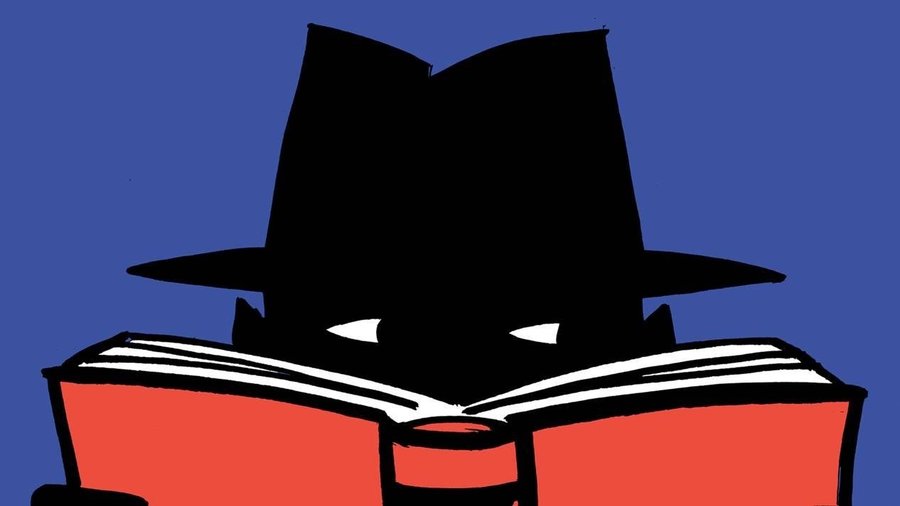Table of Contents
FOR ELEMENTARY-LEVEL MYSTERY READERS
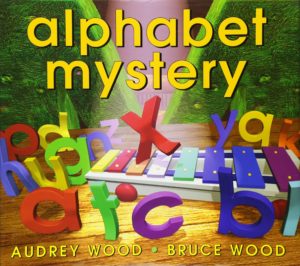
|
In Audrey Wood’s Alphabet Mystery (Blue Sky Press, 2003), Little x – depressed because he’s never used – runs away from home and it’s up to the other letters of the alphabet to find him in time for Charley’s mother’s birthday party. For ages 3-7. |
| Also see ABC: Much More Than the Alphabet. | |
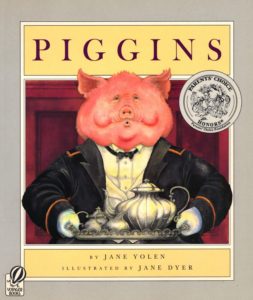
|
In Jane Yolen’s picture book Piggins (Sandpiper, 1992), the Reynards have thrown an elegant dinner party to show off Mrs. Reynard’s new diamond necklace. Then the lights go out – and when they come on again, the necklace (horrors!) is gone. Luckily Piggins, the Reynards’ savvy and elegant butler, is able to follow the clues to identify the culprit. For ages 4-8.
Sequels include Picnic with Piggins and Piggins and the Royal Wedding. |
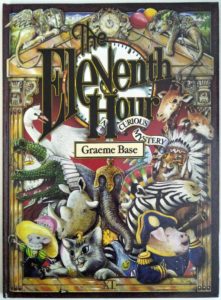
|
In Graeme Base’s The Eleventh Hour: A Curious Mystery (Puffin, 1997), Horace the elephant turns eleven, and decides to celebrate his birthday with a banquet and a costume party. Dozens of gorgeously outfitted animals show up – only to find that the birthday feast has been stolen. Riddles and clues allow readers to figure out just whodunit. Also by Base, see Enigma: A Magical Mystery. For ages 5 and up. |
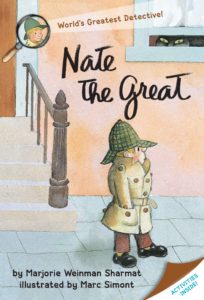
|
The star of Marjorie Weinman Sharmat’s Nate the Great (Delacorte Books for Young Readers, 2002) is a miniature detective in trench coat and deerstalker cap, who – in company with his faithful dog, Sludge – competently solves mysteries. There are many sequels, all hilarious in a deadpan sort of way. (“My name is Nate the Great. I am a detective. I work alone.”) For ages 5-9. |
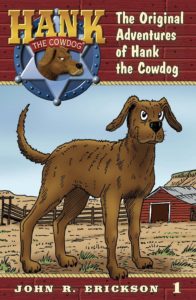
|
In John Erickson’s Hank the Cowdog Series, beginning with The Original Adventures of Hank the Cowdog (Maverick Books, 2011), the ever-suspicious Hank is the head of security on a Texas ranch where – with the help of his assistant, Drover (whose old leg wound acts up at the least hint of danger) – he solves giggle-provoking mysteries involving Night-Stalking Bone Monsters, Swirling Killer Tornadoes, Kidnapped Collies, and Vampire Cats. For ages 5-9. |
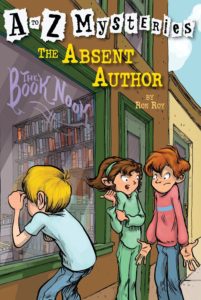
|
Ron Roy’s A to Z Mysteries Series consists of 26 short chapter books, from The Absent Author (Random House, 1997) to The Zombie Zone (2005). In each, friends Dink, Josh, and Ruth Rose use logic and imagination to solve mysteries. For ages 6-9. |
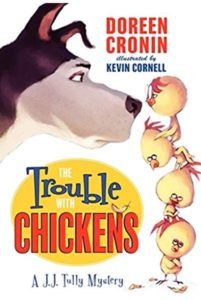
|
The detective of Doreen Cronin’s The Trouble With Chickens (Balzer + Bray, 2012) is cynical J.J. Tully, retired search-and-rescue dog, co-opted by Millicent, an upset hen, to track down her missing chicks. For ages 6-10. |
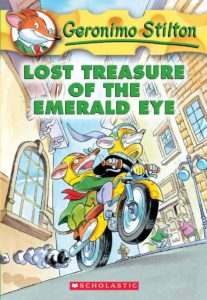
|
Purportedly by Geronimo Stilton, mouse journalist for The Rodent’s Gazette, this series of adventurous mysteries begins with Lost Treasure of the Emerald Eye (Scholastic, 2004) in which Geronimo and friends set out to look for treasure on a desert island. There are many sequels, all fast-paced and addictive reads, with catchy texts printed in a variety of colors and fonts. For ages 7-10. |
| For more on Geronimo Stilton, see Geronimo Stilton World, which features games, books, and activities. (Write your own article for The Rodent’s Gazette.) | |
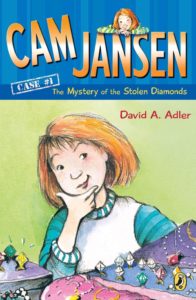
|
In David Adler’s Cam Jansen Series, targeted at upper-elementary-level readers, each of the (many) titles is 64 pages long and stars a fifth-grade sleuth officially named Jennifer. She has a photographic memory which helps her solve mysteries; hence her nickname “Camera” (“Cam” for short). Book #1 is Cam Jansen and the Mystery of the Stolen Diamonds (Puffin, 2004). For ages 7-10. |
| Younger readers can follow the adventures of Cam in the Young Cam Jansen Series, which features a younger Cam and shorter simpler (32-page) mysteries. First title in the series is Young Cam Jansen and the Dinosaur Game (Penguin Young Readers, 1998). For ages 5-7. | |
| For more information, study guides to accompany the books, summaries of all thirty Cam Jansen stories, and memory quizzes and brain teasers for kids, visit the Cam Jansen Mysteries website. | |
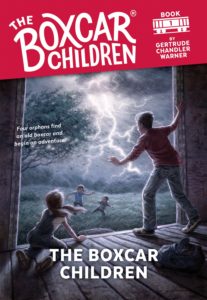
|
Gertrude Chandler Warner’s The Boxcar Children, originally published in 1942, introduces orphaned siblings Henry, Jessie, Violet, and Benny who, threatened with separation, set up home for themselves in an abandoned boxcar. There are dozens of sequels, in which the children – now living in luxury with their wealthy grandfather – solve many mild mysteries. For ages 7-10. |
| For book lists, a downloadable activity guide, background information, and more, see the Boxcar Children website. | |
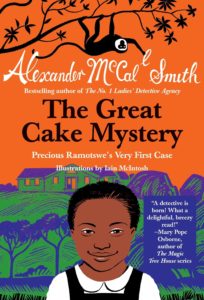
|
Alexander McCall Smith’s The Great Cake Mystery (Anchor Books, 2012), set in Botswana, stars Smith’s heroine Precious Ramotswe of the No. 1 Ladies’ Detective Agency as a young girl. Here, she solves her first case, when a pudgy classmate is unfairly accused of stealing sweets. For ages 7-10. |
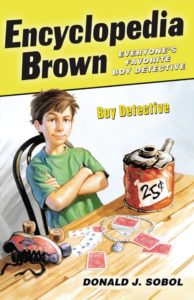
|
Donald Sobol’s Leroy (a.k.a. “Encyclopedia”) Brown. son of the Idaville, Florida, police chief, is a very knowledgeable ten-year-old, and in each of the many books in the series he uses his wits to solve several intriguing mysteries. Each story ends with a question, giving readers a chance to come up with their own explanations before discovering the truth according to Encyclopedia Brown. First book in the series is Encyclopedia Brown: Boy Detective (Perfection Learning, 2010), in which Encyclopedia and sidekick Sally Kimball solve ten mysteries, variously dealing with a Civil War sword, a diamond necklace, a stabbed watermelon, and a pair of missing roller skates. For ages 7-12. |
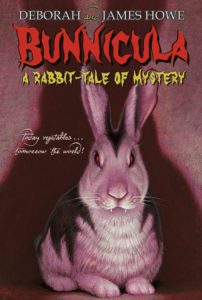
|
In James and Deborah Howe’s Bunnicula: A Rabbit Tale of Mystery (Atheneum Books for Young Readers, 2006), narrated by Harold, the family dog, the Monroe family brings home a bunny, found abandoned in a movie theater during a showing of Dracula. Soon white sucked-dry vegetables begin to appear, and Chester – the literate and hysterical family cat – becomes convinced that Bunnicula is a vampire. There are several sequels. For ages 7-11. |
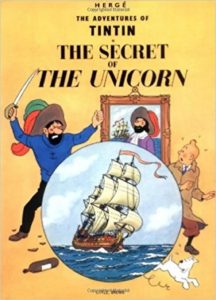
|
Hergé’s Tintin, boy detective/journalist, is the star of a text-heavy comic book series, originally published in Europe during the 1930s and 40s. The stories are clever, funny, and interest-grabbing, and are presented in a format that appeals to all, including the text-shy. There are some 20 titles (published by Little, Brown), among them The Castafiore Emerald, Red Rackham’s Treasure, The Calculus Affair, and Cigars of the Pharaoh. For background information, book synopses, descriptions of key characters – among them the irascible Captain Haddock, the dimwitted detective duo Thomson and Thompson, and the eccentric scientist Professor Calculus – and a Tintin store, see The Adventures of Tintin website. |

|
The Adventures of Tintin (2011), directed by Steven Spielberg, is a computer-animated movie based on three Tintin books: The Crab with the Golden Claws (1941), The Secret of the Unicorn (1943), and Red Rackham’s Treasure (1944). It’s rated PG because (1) there are sword fights and (2) Captain Haddock drinks. |
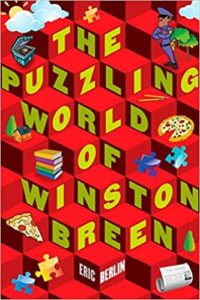
|
In Eric Berlin’s The Puzzling World of Winston Breen (Puffin, 2009), Winston sees puzzles everywhere. When his little sister Katie finds a hidden puzzle – strips of wood with words printed on them – in the false bottom of an old box that Winston bought her for a birthday present, Winston, Katie, and a large and varied cast of characters become involved in a high-stakes treasure hunt that involves – yes – lots of puzzles. Sequels include The Potato Chip Puzzles and The Puzzler’s Mansion. For ages 8-12. |
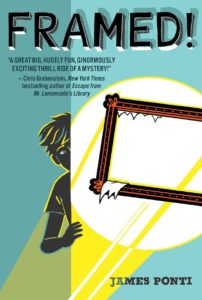
|
James Ponti’s Framed (Aladdin, 2017), the first of a mystery series, stars 12-year-old Florian Bates, whose Theory of All Small Things (TOAST) allows him to solve mysteries large and small. In this book, Florian and friend Margaret tackle a mystery involving the National Gallery of Art and a crime syndicate known as EEL. For ages 8-12. |
 |
In Chris Grabenstein’s Escape from Mr. Lemoncello’s Library (Yearling, 2014), the town library has been designed by a world-famous game maker and Kylie and friends – locked in – must solves puzzles to get out. Several sequels. For ages 8-12. |
| More escapes! Check out this list of recommended escape room games for kids and families. | |
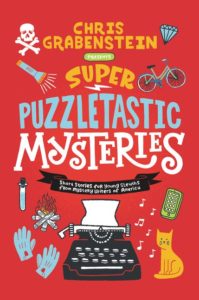 |
The reader gets to be the detective in Super Puzzletastic Mysteries (HarperCollins, 2020), an anthology of thoroughly puzzling cases from a range of best-selling authors involving everything from stolen squirrel monkeys to murderous triplets. For ages 8-12. |
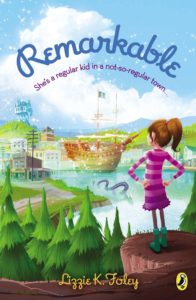
|
In Lizzie K. Foley’s Remarkable (Dial, 2012), the residents of the town of Remarkable are all impressively above average – except ten-year-old Jane Doe who, unlike her mother (famous architect), father (renowned novelist), brother (talented artist), and sister (brilliant mathematician), is just plain ordinary. When disaster strikes, however, variously involving the wicked Grimlet twins, pirates, a lake monster, and a mystery involving a missing composer, unremarkable Jane comes into her own. For ages 8-12. |
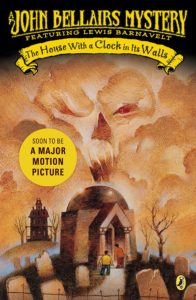
|
John Bellairs’s The House With a Clock in its Walls (Puffin, 2004) – illustrated by Edward Gorey – is a terrific (and spooky) middle-grade Gothic mystery novel. Orphaned Lewis Barnavelt is sent to live with his Uncle Jonathan, a wizard, whose mysterious mansion harbors, hidden in its walls, a Doomsday clock, set to bring about the end of the world. Lewis must – somehow – figure out how to stop the clock. There are many other titles by Bellairs in the same vein. For ages 8-12. |
| For an annotated list of Bellairs’s books, a biography of John Bellairs, and more, see http://www.bellairsia.com/. | |
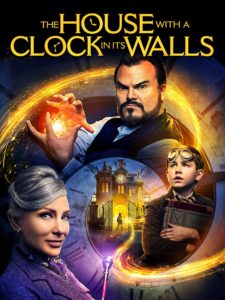
|
The 2018 movie version of The House With a Clock in its Walls is rated PG for scary pumpkins and name-calling. |
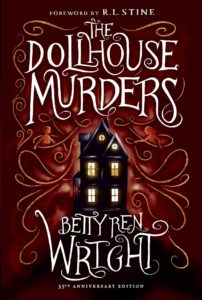
|
In Betty Ren Wright’s The Dollhouse Murders (Holiday House, 2008), Amy finds a wonderful dollhouse in the attic of the old family home – in fact, a perfect replica of the house itself. Eerily, however, the dolls move around on their own, and Amy is convinced that they hold the key to the long-ago murder of her great-grandparents. For ages 9-12. |
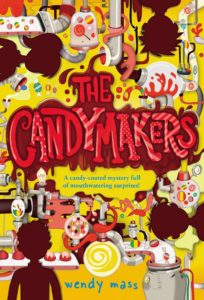
|
Wendy Mass’s The Candymakers (Little, Brown Books for Young Readers, 2011) – in which four very different 12-year-olds are chosen to compete in a national candy-making contest – sounds at first like a tale of Willie Wonka, but soon turns into a gripping mystery story filled with complex and unexpected characters, sabotage, and spies. For ages 9-12. |
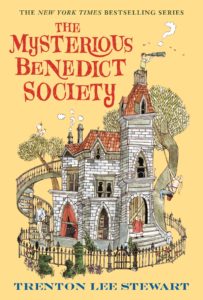
|
In Trenton Lee Stewart’s The Mysterious Benedict Society (Little, Brown Books for Young Readers, 2008), four creative and gifted children are recruited by the mysterious Mr. Benedict for a crucial mission: they must infiltrate the nefarious Mr. Curtain’s Learning Institute for the Very Enlightened and unmask his plot to take over the world. There are several sequels in which the talented foursome tackle even more harrowing missions. For ages 9-12. |
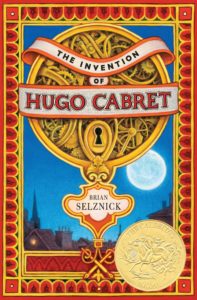
|
In Brian Selznick’s exquisitely illustrated The Invention of Hugo Cabret (Scholastic, 2007), set in the 1930s, young Hugo, an orphan, lives secretly behind the walls of a Paris train station, keeping the clocks in working order and struggling to repair a marvelous artifact once belonging to his father: a mechanical man, designed to write messages. The book is a fascinating and multifaceted mystery, told in a mix of pictures and text, ultimately involving the brilliant and bookish Isabelle, a mysterious notebook, and a famous illusionist and master of silent film. For ages 9 and up. |
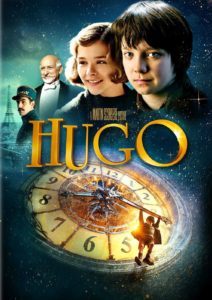
|
The 2011 film Hugo, based on Selznick’s book and directed by Martin Scorsese, is rated PG, apparently for kissing, smoking, and a derailed train scene. |
